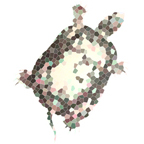Posts Tagged maps
Book Review: The Cartographer’s Coloring Book
Posted by Matthew Bettelheim in Arts & Crafts, Humor on April 1, 2018
 The Cartographer’s Coloring Book, by Terre N. Reliffe, Feaux•Afield Guides (www.feauxafieldguides.com), 2018, 41 pages, $11.95
The Cartographer’s Coloring Book, by Terre N. Reliffe, Feaux•Afield Guides (www.feauxafieldguides.com), 2018, 41 pages, $11.95
Following in the footsteps of The Synesthesia Activity Book, 2016’s break-out adult coloring book, Feaux•Afield Guides is back with an exciting new activity book for GIS junkies, The Cartographer’s Coloring Book.
If you are an adherent to coloring inside the lines, look no further – you can rack up some soothing exercise as you change altitude from the comfort of your own home with nothing but a crayon! Make your own watershed moment with the Wetlands and Watercolors of the U.S. watercolor-by-numbers exercises. Or try your hand at ending the drought by connecting the dots of any blue-line streams to turn ephemeral creeks into perennial streams. By simply following the signature curves of each topographic line, you can bring the landscape to life. Is it a hill? Is it a dale? You decide!
But nowhere is the marriage of maps and arts and crafts more celebrated than Feaux•Afield’s centerpiece, a centerfold-out quadrangle maze that allows you to challenge your friends to see who can finish the labyrinth in 7½ minutes or less! And when you are done, make sure to rock-paper-scissors to see who gets to re-fold that very same 72-panel centerfold map in as much time. For those of you old enough to remember AAA road-maps, you can relive your family vacations all over again!
This activity book, which elevates cartography to a higher plane, is sure to make your cartographic comrades G – I – S – jealous. The Cartographer’s Coloring Book is slated to hit bookshelves April 1st.
{APRIL FOOLS DAY POST 2018}
A Cross-Section of California
Posted by Matthew Bettelheim in Geology, History, Mount Diablo on November 11, 2014
 In the 1850’s, with the California Gold Rush in full swing, the United States was looking into connecting the Atlantic and Pacific coasts with a transcontinental railway; thus, the Pacific Railroad Surveys were born. After Congress passed the Pacific Railroad Survey bill in 1853, four east-west survey routes were quickly approved by the Army Corps of Topographical Engineers: within months, Corps lieutenants Robert S. Williamson and John G. Parke were given the orders to survey between the West Coast’s 32nd and 35th parallels for potential passes through the Sierra Nevada to connect the San Joaquin and Tulare Valleys with the Colorado River. Accompanying Williamson and Parke was geologist and mineralogist William P. Blake.
In the 1850’s, with the California Gold Rush in full swing, the United States was looking into connecting the Atlantic and Pacific coasts with a transcontinental railway; thus, the Pacific Railroad Surveys were born. After Congress passed the Pacific Railroad Survey bill in 1853, four east-west survey routes were quickly approved by the Army Corps of Topographical Engineers: within months, Corps lieutenants Robert S. Williamson and John G. Parke were given the orders to survey between the West Coast’s 32nd and 35th parallels for potential passes through the Sierra Nevada to connect the San Joaquin and Tulare Valleys with the Colorado River. Accompanying Williamson and Parke was geologist and mineralogist William P. Blake.
The party departed July 10, 1853, taking a ferryboat across the Carquinez Strait to Martinez where, skirting the flanks of Mount Diablo, the expedition headed south, reaching the vast San Joaquin Valley in a week’s time. By August 8th, the travelers had reached the foothills of the Sierra Nevada and established a camp they dubbed “Poso Depot” after the nearby and near-dry Poso Creek (also referred to as “Ocoya Creek” and “Posé Creek”) in present-day Kern County. Two days later, Williamson and Parke set out for the Sierra, leaving Blake and Heermann at the Depot to explore the region on their own. At some point during the expedition, the geologist Blake began preparing what would later become a series of panoramic fold-out geological section maps for publication in the survey’s final “Geological Report.” One of these maps, the 1853 “Geological Section of the Coast Range and Sierra Nevada,” charts the change in elevation along a cross-section of California from the Farallones (Farallon) Islands sea stacks and islands off the Pacific Coast to the Walkers (Walker) River in the Great Basin of west central Nevada.
(click to enlarge)
Painting this 270-mile cross-section with a broad brush, the breadth of Blake’s panorama includes, from west-to-east, Point Lobos (Land’s End), Fort Point (the ruins of the old Spanish fort, the Castillo de San Joaquin and the present-day Presidio of San Francisco), San Francisco, Yerba Buena (Yerba Buena Island), the Bay of San Francisco, Mount Diablo, Livermore Pass (Livermore), Elk Horn (undetermined), the Delta of the San Joaquin River, Stockton, Knight’s Ferry, Green Spring (undetermined), and Sonora. Blake’s geological section puts to paper the elevational rise and run of California with peaks that seem to dwarf the shorelines and floodplains in orders of magnitude. Rising from the sea stacks of the 1/16-inch Farallon Islands (~312 feet; actual = 357 feet) to the 3/4-inch peak of Mount Diablo (~3,750 feet; actual = 3,849 feet) to the towering heights of the Sierra Nevada’s 2 ½-inch Tower Peak (~12,500 feet; actual = 11,755 feet), at a vertical scale of 5,000 feet per inch, Blake captures California’s vertiginous vista with surprising accuracy.












